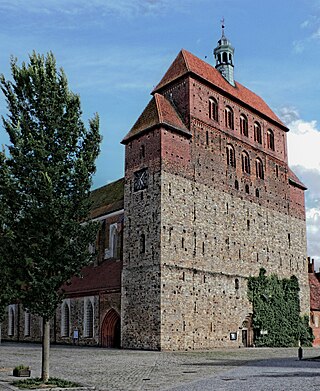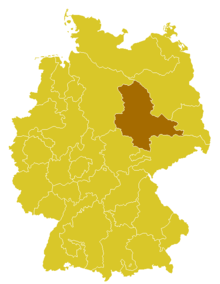
Joachim I Nestor was a Prince-elector of the Margraviate of Brandenburg (1499–1535), the fifth member of the House of Hohenzollern. His nickname was taken from King Nestor of Greek mythology.

The Electorate of Mainz, previously known in English as Mentz and by its French name Mayence, was one of the most prestigious and influential states of the Holy Roman Empire. In the hierarchy of the Catholic Church, the Archbishop-Elector of Mainz was also the Primate of Germany, a purely honorary dignity that was unsuccessfully claimed from time to time by other archbishops. There were only two other ecclesiastical Prince-electors in the Empire: the Electorate of Cologne and the Electorate of Trier.

The Prince-Archbishopric of Bremen — not to be confused with the modern Archdiocese of Hamburg, founded in 1994 — was an ecclesiastical principality (787–1566/1648) of the Holy Roman Empire and the Catholic Church that after its definitive secularization in 1648 became the hereditary Duchy of Bremen. The prince-archbishopric, which was under the secular rule of the archbishop, consisted of about a third of the diocesan territory. The city of Bremen was de facto and de jure not part of the prince-archbishopric. Most of the prince-archbishopric lay rather in the area to the north of the city of Bremen, between the Weser and Elbe rivers. Even more confusingly, parts of the prince-archbishopric belonged in religious respect to the neighbouring Diocese of Verden, making up 10% of its diocesan territory.

The Archbishopric of Magdeburg was a Latin Catholic archdiocese (969–1552) and Prince-Archbishopric (1180–1680) of the Holy Roman Empire centered on the city of Magdeburg on the Elbe River.
A Diocesan Administrator is a provisional ordinary of a Catholic particular church.

The Diocese of Halberstadt was a Roman Catholic diocese from 804 until 1648. From 1180, the bishops or administrators of Halberstadt ruled a state within the Holy Roman Empire, the prince-bishopric of Halberstadt. The diocesan seat and secular capital was Halberstadt in present-day Saxony-Anhalt.

Huysburg is a Benedictine monastery situated on the Huy hill range near Halberstadt, in the German state of Saxony-Anhalt. The Romanesque abbey has existed since about 1080 and was secularised in 1804. A new Benedictine community was founded in 1972 and has been headed by a prior since 1984.

The Archdiocese of Wrocław is a Latin Church ecclesiastical territory or archdiocese of the Catholic Church centered in the city of Wrocław in Poland. From its founding as a bishopric in 1000 until 1821, it was under the Archbishopric of Gniezno in Greater Poland. From 1821 to 1930 it was subjected directly to the Apostolic See. Between 1821 and 1972 it was officially known as (Arch)Diocese of Breslau.
The Vicariate Apostolic of Northern Germany, known for most of its existence as the Vicariate Apostolic of the NorthernMissions, was a Catholic missionary jurisdiction established on 28 April 1667. It belonged to a vicar apostolic in predominantly Protestant Northern Europe.

The Diocese of Lebus is a former diocese of the Catholic Church. It was erected in 1125 and suppressed in 1598. The Bishop of Lebus was also, ex officio, the ruler of a lordship that was coextensive with the territory of the diocese. The geographic remit included areas that are today part of the land of Brandenburg in Germany and the Province of Lubusz in Poland. It included areas on both sides of the Oder River around the town of Lebus. The cathedral was built on the castle hill in Lubusz and was dedicated to St Adalbert of Prague. Later, the seat moved to Górzyca, back to Lebus and finally to Fürstenwalde on the River Spree.

The Archdiocese of Berlin is a Latin Church ecclesiastical territory or archdiocese of the Catholic Church in Germany. The archepiscopal see is in Berlin, with the archdiocese's territory extending over Northeast Germany.

The Diocese of Dresden–Meissen is a Latin Church diocese of Catholic Church in Germany with its seat in Dresden. It is suffragan to the Archdiocese of Berlin.

The Bishopric of Merseburg was an episcopal see on the eastern border of the medieval Duchy of Saxony with its centre in Merseburg, where Merseburg Cathedral was constructed. The see was founded in 967 by Emperor Otto I at the same time in the same manner as those of Meissen and Zeitz, all suffragan dioceses of the Archbishopric of Magdeburg as part of a plan to bind the adjacent Slavic ("Wendish") lands in the Saxon Eastern March beyond the Saale River more closely to the Holy Roman Empire.

The Bishopric of Havelberg was a Roman Catholic diocese founded by King Otto I of Germany in 946, from 968 a suffragan to the Archbishops of Magedeburg. A Prince-bishopric (Hochstift) from 1151, Havelberg as a result of the Protestant Reformation was secularised and finally annexed by the margraves of Brandenburg in 1598.

The Prince-Bishopric of Paderborn was an ecclesiastical principality (Hochstift) of the Holy Roman Empire from 1281 to 1802.

The Diocese of Görlitz is a Latin Church diocese of the Catholic church in Germany. The current ordinary is Wolfgang Ipolt

In the Holy Roman Empire, the German term Hochstift referred to the territory ruled by a bishop as a prince, as opposed to his diocese, generally much larger and over which he exercised only spiritual authority. The terms prince-bishopric and ecclesiastical principality are synonymous with Hochstift. Erzstift and Kurerzstift referred respectively to the territory (prince-archbishopric) ruled by a prince-archbishop and an elector-archbishop while Stift referred to the territory ruled by an imperial abbot or abbess, or a princely abbot or abbess. Stift was also often used to refer to any type of ecclesiastical principality.

The Prince-Bishopric of Verden was an ecclesiastical principality of the Holy Roman Empire that was located in what is today the state of Lower Saxony in Germany. Verden had been a diocese of the Catholic Church since the middle of the 8th century. The state was disestablished in 1648. The territory was managed by secular lords on behalf of the Bishop of Verden. As a Prince-Bishopric of the Empire, the territory of the state was not identical with that of the bishopric, but was located within its boundaries and made up about a quarter of the diocesan area. By the terms of the Peace of Westphalia, the Prince-Bishopric was disestablished and a new entity was established, the Duchies of Bremen and Verden.

Leo Nowak is a German Roman Catholic prelate who was the first bishop of the newly re-erected Roman Catholic Diocese of Magdeburg, Germany, from 1994 until 2001. He was born in Magdeburg.

Johannes Braun was a Roman Catholic Bishop and an Apostolic Administrator in Magdeburg.


















